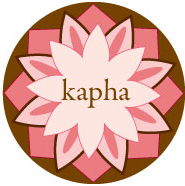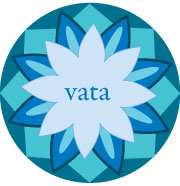Ayurvedic Glossary
Abhyanga
A rejuvenating Ayurvedic warm oil massage that deeply recharges mind and body, abhyanga is amongst the cornerstone practices and treatments given in Ayurveda. It helps loosen and facilitate the removal of accumulated ama (toxicity) and elemental or energetic imbalances throughout the body.
Agni
Agni is the Ayurvedic term for digestive fire that symbolizes the power of one’s digestive metabolism. When agni is strong, food is digested properly and a person feels light and healthy. When agni is weak, toxins (undigested food particles) build up in the body and a person may feel heavy or sluggish. Agni is stimulated through the use of spices and fresh herbs in Ayurvedic cooking and strengthened through Ayurvedic cleansing.
Ama
Ama represents natural waste products, like feces and mucous, that get stored in the body rather than eliminated; thus creating toxic or undigested waste in the body. Ama is a result of weak agni, poor metabolism or a lack of strong digestive fire. Overeating, malabsorption and overconsumption of difficult to digest foods contribute to weak agni and high ama.
Anjali
An anjali (pronounced An-jah-lee) is a measurement made by cupping or holding your hands together so that they form a bowl. In Ayurveda, this measurement is considered to be the “right” serving size for your body at a mealtime, as it reflects the same size of your stomach and allows for an amount of food your body can comfortably metabolize without creating ama or a feeling of over-fullness.
Ayurveda
The science of life, or science of the self. Over 5000 years old, originating from India, yoga is its sister science. Deepak Chopra says it best: “More than a mere system of treating illness, Ayurveda is a science of life (Ayur = life, Veda = science or knowledge). It offers a body of wisdom designed to help people stay vibrant and healthy while realizing their full human potential.”
Astringent
In Ayurveda, astringent represents the taste of air and earth. It is cold and tonifying. Tastes associated with astringent (like pomegranate seeds, raspberries and beans) balance Pitta and Kapha and imbalance Vata.
Bitter
In Ayurveda, bitter represents the taste of air and ether. It is cold and dry. Tastes associated with bitter (like kale, cilantro and aloe vera juice) balance Pitta and Kapha and imbalance Vata.
Dhatus
Dhatus are the seven basic tissues that support and maintain the structures, systems and functions of the body. Each tissue feeds and nourishes the one that proceeds it. Lymph (rasa) feeds blood (rakta), which nourishes muscle (mamsa), which burns fat (meda) which builds bone (asthi), which strengthens nerves and bone marrow (majja) and nourishes reproductive tissues (shukra/artav). When one dhatu is unhealthy, stuck or stagnant, it negatively affects the other tissues. Food (and food’s post-digestive effect) provides the basic nutrition of the dhatus.
Dosha
In Ayurveda, there are three biologically-based, constitutional types known as the Doshas: Vata, Pitta and Kapha. Together they represent the five natural elements of life – ether, air, fire, water and earth – that are the foundation of Ayurvedic medicine. Vata is made from ether and air and represents the concept of wind, movement and change. Pitta is born from fire and water and represents the concept of heat, transformation and focus. Kapha is the union of water and earth and represents the concept of mud, flow and nourishment. The Doshas are natural forces found in every living thing. Their natural tendency is to easily go out of balance, which causes symptoms in the body to manifest. Ayuveda is a science dedicated to keeping these Doshas balanced through the proper application of food, nutrition, exercise and lifestyle.
Ghee
Clarified butter. Considered a superfood in Ayurveda, ghee is unsalted butter transformed. When you clarify butter, you remove water and protein solids – ghee is the clear, golden liquid left behind. It’s warm, light, and lubricating and revered for its ability to carry nutrition deep into the tissues.
Gunas
Attributes or qualities found in the five elements of nature: ether, air, fire, water and earth. They refer to the specific qualities of the five elements as they are expressed through the Doshas: Vata, Pitta and Kapha. For example, Vata – made from air and ether – possesses the qualities of cold, dry, light and subtle. Pitta – formed by fire and water – has attributes of sharp, hot, penetrating and oily. Kapha – the union of water and earth – is cool, wet, slow, slimy and heavy.
Universally speaking, gunas represent the three foundational principles of creation or basic laws of nature. In Ayurveda, these principles are called rajas, tamas and sattva. Rajas is the active force of movement. Tamas is the inactive quality of inertia. Sattva is the pure, balanced, creative potential inherent in all living things. There are rajasic (active), tamasic (dull) and sattvic (pure) qualities inherent to each of the three Doshas.
Kapha
One of the three Doshas (with Vata and Pitta), Kapha represents the union of water and earth. It is slow, soft, cool, wet, oily, dense, sticky and heavy. Kapha rules the biological functions of lubrication and hydration.
Ojas
In Ayurveda, ojas is a Sanskrit term literally translated to mean “vigor”. Ojas represents the strength of the body’s vital fluids (like blood and reproductive fluids). The quality of your ojas is representative of your overall health, immunity, wellness and vitality. When ojas is healthy, the body, mind and spirit thrive. When ojas is depleted, the body, mind and spirit are weak or in a state of dis-ease.
Pancha Karma
A deeply healing, nourishing, personal and transformational Ayurvedic cleanse, pancha karma refers to the sacred cleansing and rejuvenating treatments that detoxify, purify and re-build the physical, emotional and spiritual body.
Pitta
One of the three Doshas (with Vata and Kapha), Pitta represents the elements of fire and water. It is hot, light, sharp, oily, penetrating and spreading. Pitta rules the biological functions of digestion, perception and body temperature regulation.
Prakruti
In Ayurveda, prakruti represents the most basic principle of the universe – creation. It stands for innate elemental constitution, or one’s Dosha. Prakruti is determined at the time of conception and is set at the moment you take your first breath. The unique combination of elements present at birth are genetically, hereditarily and karmically determined and do not change throughout one’s life. Ayurvedic practitioners often refer to a person’s Prakruti as their “birth pulse”.
Pungent
In Ayurveda, pungent represents the taste of air and fire. It is hot and stimulating. Tastes associated with pungent (like garlic, ginger and basil) balance Kapha and imbalance Pitta and Vata.
Rajas
One of the three gunas (with sattva and tamas), rajas is the active, kinetic quality of life.
Rasa
The initial experience of taste, when something is first placed on the tongue. The six rasas of Ayurveda are sweet, salty, sour, bitter, pungent and astringent.
Salty
In Ayurveda, salt represents the taste of fire and water. It is warm and moist. Tastes associated with salt (like sea vegetables, celery and tamari) balance Vata and imbalance Pitta and Kapha.
Samkhya
Samkhya is the philosophy of creation upon which Ayurveda is based.
Sanskrit
The ancient language of India, also known to be a language of higher consciousness.
Sattva
One of the three gunas (with rajas and tamas), sattva is the pure, balanced quality of existence. Sattvic foods are balancing for all body types (or Doshas).
Sour
In Ayurveda, pungent represents the taste of fire and earth. It is warm and heavy. Tastes associated with sour (like lemon, tomato and vinegar) balance Vata and imbalance Pitta and Kapha.
Sweet
In Ayurveda, sweet represents the taste of water and earth. It is rich and heavy. Tastes associated with sweet (like rice, squash and sweet potato) balance Vata and Pitta and imbalance Kapha.
Tamas
One of the three gunas (with rajas and sattva), tamas represents the dull, inert, destructive quality of nature.
Vata
One of the three Doshas (with Pitta and Kapha), Vata represents the elements of air and ether. It is cold, dry, light, mobile, subtle. Vata rules the biological functions of movement, breath, elimination and sensation.
Vipak
The post-digestive effect or, long-term impact, a food or taste has on the body after chewing, absorption and assimilation is called vipak. This post-digestive impact is a product of the initial taste taken on the tongue. Vipak is always sweet (resulting from sweet or salty tastes), sour ( a result of sour tastes) or pungent (resulting from bitter, pungent or astringent tastes).
Virya
In Ayurveda, virya refers to the action or energetic temperature (heating or cooling) a food has on the body after it’s ingested. Herbs and spices have a specific virya that is either heating or cooling. For example, the virya of aloe vera is cooling. It cools the body and therefore benefits Pitta



